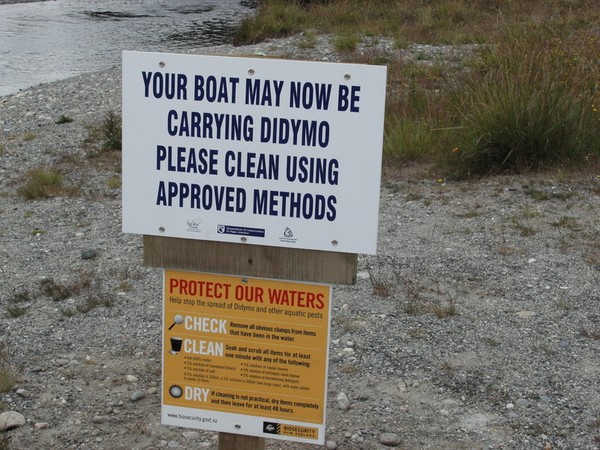Central North Island river users reminded to check, clean and dry

With the discovery of dead didymo cells in several central North Island rivers yesterday, MAF Biosecurity New Zealand (MAFBNZ) and Central North Island regional partner organisations are reminding anglers and other recreational freshwater users to check, clean and dry their equipment between waterways.
Dead didymo cells were found in some samples of water taken late last week from the Tongariro, Whakapapa, Mangatepopo and Whanganui Rivers as part of Genesis Energy’s monthly water quality sampling programme. Results were confirmed yesterday (31 October).
“Staff from the Department of Conservation, MAFBNZ, and Fish & Game will be at popular spots in those areas reminding river users to check items and to thoroughly decontaminate any equipment they have been using,” said David Hayes, MAFBNZ biosecurity response manager.
“Live cells need to be present before a waterway can be confirmed as infected with didymo, but every sample like this merely reinforces the need for freshwater users to check, clean and dry between waterways.”
All items should be cleaned for at least one minute with a five percent solution of dishwashing liquid or nappy cleaner, dried to the touch and left for another 48 hours before use in another waterway.
The application method is equally important, as water absorbent materials such as felt-soled waders and boots require longer soaking times to allow thorough saturation.
Felt-soled waders require soaking for at least 40 minutes in hot water kept above 45 °C or soaking for 30 minutes in hot water kept above 45 °C containing five percent dishwashing detergent or nappy cleaner.
Anglers may wish to use rubber-soled footwear instead, which are easier to clean and dry.
If cleaning an item was not practical, it should be allowed to dry. Once touch dry, it should be left dry for another 48 hours. Freezing any item until solid will also kill didymo. If cleaning or drying is not practical, restrict equipment to a single waterway.
“This is something all people should be doing regardless of location or perceived risk.”
The dead didymo cells were in samples taken from two sites on the Tongariro River – Puketatara and downstream of the Rangipo Dam, and the one site each on the Whakapapa, Mangatepopo and Whanganui Rivers. The samples were taken as part of Genesis Energy’s monthly water quality sampling programme.
All sites where dead didymo cells were found will be retested as well as several other sites nearby which have been identified as high value or high risk due to heavy use by river users. This work has already begun.
MAF Biosecurity is working with Central North Island partners including the Department of Conservation, Fish & Game, Genesis Energy, Tuwharetoa Maori Trust Board, and the New Zealand Recreational Canoeing Association.
“While no decision had been made to close the rivers, the public were being advised to where possible avoid using these rivers until the samples were analysed and a response programme implemented if required,” said David Hayes.
Sample collection and laboratory processes will also be looked at to see if there has been any cross-contamination of samples.
MAFBNZ will provide further information as soon as it is available.
More information about didymo and cleaning methods is available on the MAF Biosecurity New Zealand website www.biosecurity.govt.nz.
ENDS
